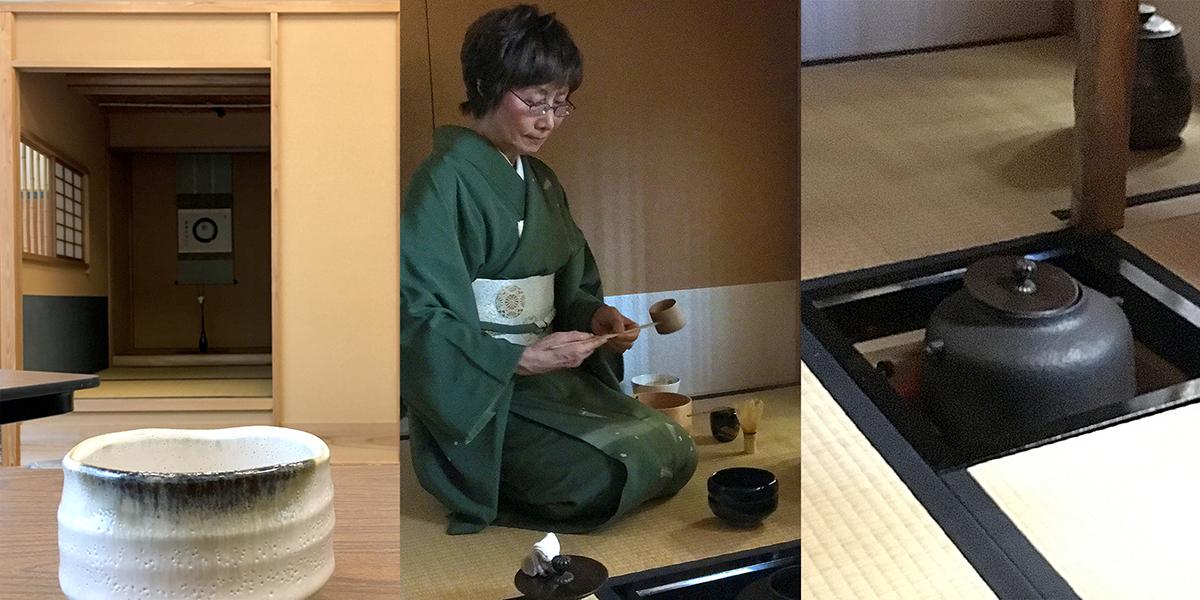
Rarely can a commodity bought, sold and consumed around the globe define a way of life, but tea is a drink shared as an important part of many cultures. Modern Languages and Literatures Professor Midori McKeon brings back the ancient art of tea drinking with the Chanoyu, or formal Japanese tea ceremony, every year in one of SF State’s best-kept secrets — an authentic tea room inside the Humanities Building.
McKeon performs the meticulous, hourlong ceremony in a careful process that emphasizes the beauty in stillness, humility and calm silence. One afternoon this November, McKeon hosted six sessions with 44 students.
Before each ceremony begins, McKeon gives insight on the history of the art form. In 1191, a priest named Yosai brought to Japan excellent tea seeds as well as the method of blending tea powder and hot water directly in a tea bowl after visiting China during the Song Dynasty (690 – 1279) to study Buddhism. Chanoyu, the ceremony also known as Way of Tea, was developed from this method and tea master Sen no Rikyu influenced the addition of spiritual elements from Zen Buddhism to Chanoyu during the 1500s.
As the four tenets of the ceremony are harmony, respect, purity and tranquility, Chanoyu is designed to transport its participants into a calming, peaceful state. Inside the dimly lit tea room, a decorative scroll hangs from the wall. A large, black circle brushed with ink represents motifs of Zen enlightenment and the recent full moon.
Students sit on their legs on tatami mats while McKeon begins her duties as teishu — or host — and sets the tools for the ceremony. One by one, she brings out the bamboo tea scoop, the tea caddy and main tea bowl, along with high-quality, freshly ground green tea flown from overseas. After treating guests with a Japanese seasonal sweet cake, she begins the process of cleaning her utensils and mixing each bowl of tea individually in near silence, taking care to make her motions simple and elegant.
McKeon presents the most beautiful side of the tea bowl to her guests. Guests turn the tea bowl 90 degrees clockwise to avoid drinking from the most beautiful front of the tea bowl. They then show their consideration by sipping the last of their tea loudly and presenting the most beautiful side of the bowl back to the host when finished.
McKeon says the ceremony’s purpose is more than just serving tea.
“Chanoyu puts people in a very special state of mind. It reminds people of the preciousness of each other’s presence and encounter,” she says. “ … Zen's emphasis of here and now underlies this notion of Ichigo Ichie (‘one meeting, one lifetime’). And, of course, Chanoyu gives people a great sense of relief from the hustle and bustle of the modern-day world and helps them regain their inner balance.”
McKeon started performing Japanese tea ceremonies on campus in 2002, after a manufacturer donated the $100,000 tea house to SF State.
Although McKeon has studied and performed the ceremony for years, she finds that she is constantly learning.
“When I first began taking tea lessons,” she reminisces, “I thought that I would be able to master the tea procedure in just a few years. How terribly wrong I was! It gradually dawned on me that studying the Way of Tea would take a lifelong pursuit.”
Chanoyu is more than a comprehensive system of hospitality that encompasses the human life basics of food, water and shelter, she adds. For McKeon, “it is all about considerations for appreciation of human beings and even objects. Therefore, spiritual training and cultivating one’s ability to appreciate art objects become crucial.”
The students who participated came from diverse backgrounds and disciplines. It is this aspect of performing the annual tea ceremony that Professor McKeon enjoys best.
“It is a great pleasure to see students of diverse academic interest and cultural background gather together in a small tea room to enjoy a bowl of tea and each other’s company,” she says.
— Gospel Cruz
Links
Photos by Gospel Cruz